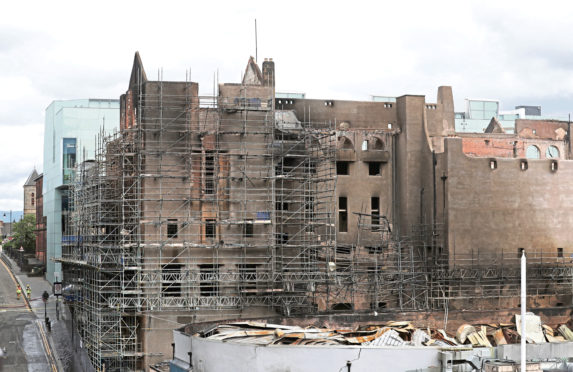
Glasgow School of Art staff have reported high levels of stress and bullying.
According to a leaked report for the crisis-hit art school, one in three staff feel “unduly stressed” at work and one in eight feel harassed or bullied.
The news follows an exodus of 70 staff from the school since a second devastating fire at the Charles Rennie Mackintosh building last year. Forty resigned and another 30 were made redundant.
Its director and finance director have also quit and its deputy director has left for another post.
A current senior member of staff said: “The relationship between senior management and the staff has been toxic on all levels for a long time.
“With one in eight staff members suffering harassment and bullying, it is understandable that half would not recommend it as a workplace.
“The most pointed of the results is that only one in four staff members, including managers, believe that communication or performance by the management is adequate.”
A former senior member of staff added: “There are many professional and talented staff at the art school who remain passionate about their work.
“In my opinion, GSA needs a new management team who recognise and this and support the team so that they can get on with their work educating students and carrying out research.”
The survey was carried out for the art school by human resources consultants Capita, who have produced figures for 35 universities.
The survey showed that 75% of staff felt “taking everything into account” GSA was a good place to work, below the benchmark for higher education institutions of 89%.
However, 49% of staff often think about quitting the art school, compared with a benchmark of 36%.
It also found 36% of staff were “unduly stressed” at work and 12% felt harassed or bullied. Some 95% of staff felt more could be done to help staff prepare for and cope with change, compared with a HEI benchmark of 79%.
Christine Pratt, director of HR and diversity management and founder of the National Bullying Helpline, said the figures suggested a “culture of fear and divide”.
“This employer needs to reiterate that it will look at and take any grievance seriously,” she said.
Glasgow School of Art said: “It is unfortunate that the results of the staff survey have been shared with the Sunday Post before they have been shared with our staff.
“The reason for undertaking any staff survey is to recognise and understand where you have weaknesses, strengths and areas for improvement, and we are already working to address these areas.
“Despite the many challenges the GSA has faced in recent years, much of which is reflected in the survey results, the underlying commitment of our staff cannot be underestimated as we collectively work to move forward.”

Enjoy the convenience of having The Sunday Post delivered as a digital ePaper straight to your smartphone, tablet or computer.
Subscribe for only £5.49 a month and enjoy all the benefits of the printed paper as a digital replica.
Subscribe